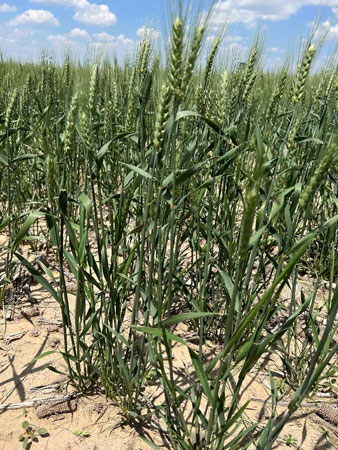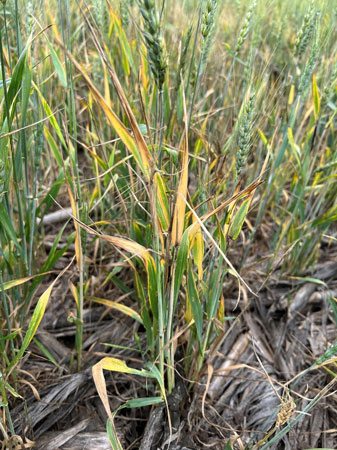Rainfall during the past three weeks has resulted in a flush of late, green tillers in the wheat over much of Kansas, especially in the northwest corner of the state (Figure 1). In south-central Kansas, where the wheat is most advanced, these late-emerged tillers may have been burned back by the heat wave from a few weeks ago (Figure 2). This can create a problem, especially for wheat that is approaching harvest maturity. A question that usually arises when this happens is: Should I wait to start harvesting until most of the green heads have matured, or just start harvesting anyway?

Figure 1. Wheat plants in Wallace Co showing later-emerged tillers during the 2023 growing season as of June 7th. Notice the shorter and later heads in the middle to lower portions of the plants. Photo by Romulo Lollato, K-State Research and Extension.

Figure 2. Late-developed tillers have aborted after a combination of two freeze events followed by a heat stress wave in south-central Kansas. About half of the total number of tillers had been aborted in this field. Photo by Romulo Lollato, K-State Research and Extension, taken at Sedgwick Co, late May 2023.
This question is more relevant for the northwest part of the state, where the wheat in the most advanced heads is already between the flowering and early grain fill stages of development, and many late-produced tillers may still be in the boot. The answer on whether to wait on these tillers to harvest or not will depend on a few factors, mostly: (1) what will the weather be like for grain filling between now and harvest, and (2) what percent of total heads is represented by the late developed ones?
In cases where these tillers don’t amount to more than 5% or so of the total amount of heads in the field, producers should not delay harvest because of the green tillers as they won’t add much to the final yield anyway. Additionally, should the temperatures increase to more normal Kansas grain-filling weather in the near future, these late-developed tillers may be more exposed to heat stress. This would potentially result in lower test weight and shriveled kernels. So, producers should start harvesting as soon as the bulk of the field is ready. With varieties that tend to shatter easily, producers should start harvesting as soon as the field reaches 15% moisture.
In the off case that we have another ~3 weeks of below-average temperatures and above-average moisture, and when the green tillers make up for a large amount of the heads in the field, waiting to harvest until all heads ripen may be justified – but the chances here are slim. For most cases, it will probably be best to just start harvesting when the majority of heads are ready to go. Waiting for the green heads to ripen might lead to the shattering of the more mature heads.
Producers should be aware that the grain in the green heads may cause some storage problems. It’s never easy to manage a late flush of green shoots in wheat. Unfortunately, there’s no clear-cut answer, nor is there one best management strategy to fit all situations.
Romulo Lollato, Extension Wheat and Forage Specialist
lollato@ksu.edu